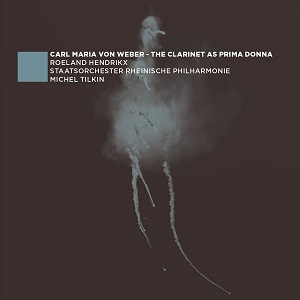
Carl Maria von Weber (1786-1826)
The Clarinet as Prima Donna
Clarinet Concerto No 1, Opus 73 (1811)
Aria of Agathe: Leise, leise, fromme Weise, from Der Freischütz (1817-21)
Clarinet Concerto No 2, Opus 74 (1811)
Variations on a theme from the opera Silvana, Opus 33 (1811)
Roeland Hendrikx (clarinet)
Staatsorchester Rheinische Philharmonie/Michel Tilkin
rec. 2022, Rhein-Mosel-Halle, Koblenz, Germany
Evil Penguin Classic EPRC0053 [66]
Here we have what is claimed to be a rather new approach to Weber’s clarinet works.
Apparently (according to the booklet notes) “Weber did not provide a fully-fledged solo part, but a melodic skeleton to be fleshed out by Baermann [the virtuoso for whom he composed these works]”. I think this is rather an over-statement. Baermann changed dynamics and added phrase-markings, grace notes and some rhythmic variation. Many instrumentalists have advised composers and contributed to modifications in their solo part, so I feel it is misguided to make heavy weather of this process. To be brief – Andreas Tarkmann has been employed to decide “how much Baermann should be peeled off to get to the real Weber”, etc. Actually, I doubt whether anyone will be startled by the results. Tarkmann has (very skilfully) added little cadenzas at appropriate points, but this is no more than many violinists do in Mozart’s concertos, for instance. A detailed account of the various performing editions may be read in the booklet.
Roeland Hendrikx has an admirable tone – clear without being at all thin – and his dynamic range is good, although it must be said that the clarinet lends itself to this more than most wind instruments. The performances in general are thoroughly musical, if a little sober. Avoidance of flashiness appeals to me, but Weber’s clarinet music is more often played with the emphasis on maximum virtuosity and extroversion. I have always believed that romance, elegance and poetry are at least as essential to Weber’s musical persona. However, having said all this, I do miss a little panache and bravura here. It’s generally quite plain, short on character and operatic temperament. The finale of the Second Concerto is better, but I still would prefer a degree more abandon. Hendrikx plays very neatly but it’s rather too pure and correct. Weber is often played with the emphasis on superficial brilliance, but such an approach does him a disservice, because he is a much finer composer than that. It’s a question of getting the balance right. If I may briefly digress: there are certain players (clarinettists and others) who relish the technically demanding passages, but sound to my ears marginally less committed in the non-virtuosic music. There are some famous violinists too, who are in their element in Paganini but sound quite bored in the Beethoven Concerto. Another illustration of this would be John Ogdon, whose enthusiastic engagement famously grew in direct proportion to the increasing technical demands of the music. While I am digressing, I would not want to become puritanical about virtuosity per se. It is as well to remember what Saint-Saëns once wrote: “What hard things have been said against virtuosity! … The fact must be proclaimed from the roof-tops – in art a difficulty overcome is a thing of beauty.”
The aria from Der Freischütz is “recomposed” by Tarkmann, who integrates fragments from the preceding recitative and from the overture. I am unconvinced that this is musically satisfying. On the other track Hendrikx plays the Silvana variations – originally for clarinet and piano but here performed in an orchestral arrangement by R. Schottstädt.
I detest the practice of graphic designers in preferring white print (often minute) on a black background. Perversely, the German-language section is black on silvery-blue. The recording is faithful and natural, if a shade reverberant.
Philip Borg-Wheeler
Help us financially by purchasing from





















